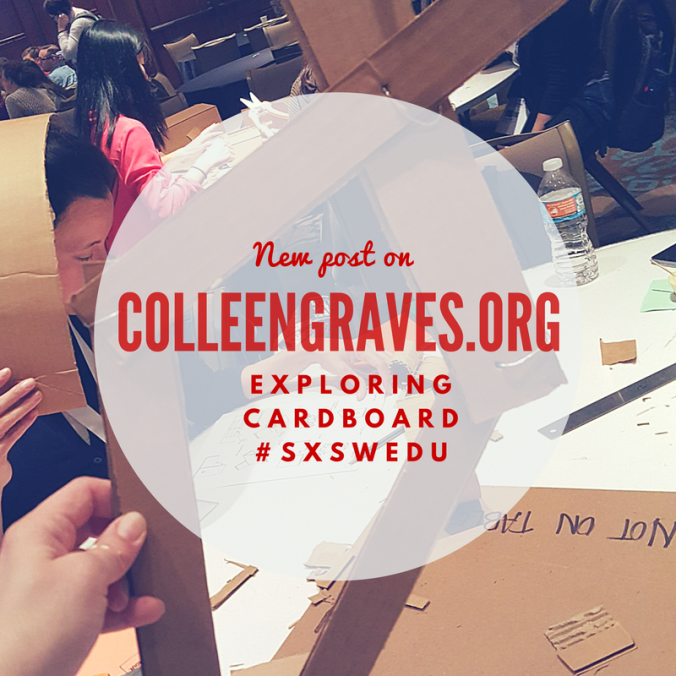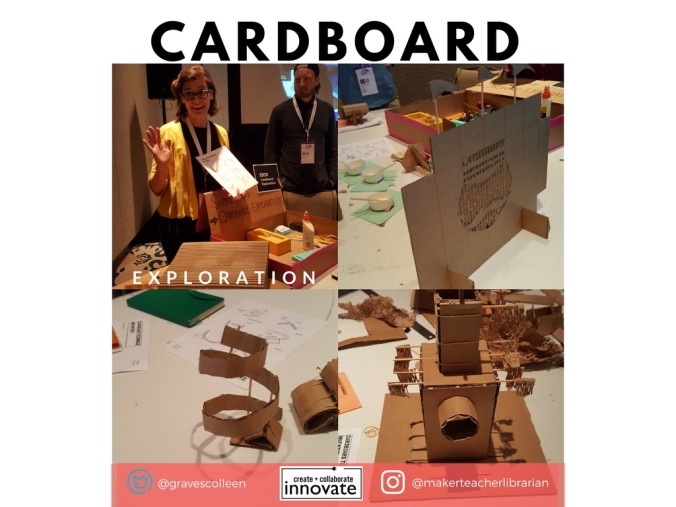This is the second post reflecting on SXSWedu 2017. Read the first post reflecting on the need for sharing our maker education classroom fails or what Sam Patterson calls the “anti-Instagram” moments.

Exploring Materials in #4ways4makered
Four Ways for MakerEd was an excellent workshop at SXSWedu hosted by Christa Flores, Patrick Benfield, Sean Justice, and Erin Riley.
These fabulous maker educators set up four different explorations across this gigantic room and gave us time to play. After introductions, I hurried to the cardboard corner and began exploring cardboard techniques thanks to this cool handout from Erin Riley.
As I sat there playing with cardboard, those around me were making and building awesome things. I was feeling a bit uninspired making-wise, plus I was nervous about my own upcoming session.
Here I was in the middle of this room of so many awesome folks who were quickly inspired and making cool stuff.
And I had no ideas.
I was starting to feel pressure, because I’m a maker and I should be able to sit down and make cool stuff,right?
No. That’s not right. Sometimes even the most creative types can be uninspired. Instead I thought, “It’s okay. I’ll just play with cardboard and try all these cool techniques since I haven’t tried some of these before.” Meanwhile, my friend Liam built a chair out of cardboard, another guy at our table built a castle, and another learner made interesting cardboard art (with shadow play!)
Meanwhile, I was still cutting pieces out, putting them together and playing with techniques. Nothing creative or amazing….

As I kept exploring cardboard, I started thinking it would be fun to play with linkages. However, there weren’t any brads to connect my pieces. I tried linking thin pieces with dowels and came up with interesting combinations, but it wasn’t really working as far as linkages go. I began to feel like I should just maybe give up, but I continued to explore the different techniques like straight cuts, smooth bends, and exposing corrugation. After awhile I decided to walk around the room to see what the other 3 groups were making. There were toy guts in one half of the room (Christa’s parts,purposes, and complexities), amazing makerspace designing in another (Patrick’s workshop), and a lightbulb/paper clip exploration (with Sean Justice.) Wait… did I just see paper clips? I bugged Sean for a few paper clips, and quickly went back to work at my table.
I cut four thin strips of cardboard and attached them with paper clips and within minutes I had a working grabber! One of my table mates suggested using the “smooth joint technique” to attach grabbers to the end of my pinchers.
So even though I felt like I didn’t have any ideas, what I really needed was time to explore the materials and tinker with techniques. I just needed an hour to mess around, and that experience led me to a quick working prototype.
This was important lesson for me. Sometimes it is OKAY for our makers to just explore materials. It’s more than okay, exploration is a necessary form of making.
When reflecting later with Patrick Benfield he said, “All making is valid.” Patrick told me how at the d.lab he makes time for his makers to explore materials before building projects. Before teaching paper circuits, he lets his students explore making art with copper tape. Another aha moment for me! What might seem like a waste (exploring copper tape by making art/ exploring cardboard techniques and just cutting up cardboard) is not actually a waste.
Instead it is a learning experience that some of our makers really need. Exploring the materials might give them the creative confidence they need to inspire paper circuit designs or make some simple cardboard grabbers.
Reflections
When I interviewed Patrick this summer for Challenge Based Learning, we discussed the importance of reflection. As a writing teacher, I always felt like my students really synthesized their learning in that last critical step – reflecting on an experience. It’s one reason I institute maker journals in my professional development workshops.
What is even more stunning is seeing other participants in the same workshop reflecting and having the same a-ha moments as me. Notice in the tweet below, Nicole Cimo goes through the same process of exploring materials, manipulating techniques, and suddenly having an aha moment that leads to that creative confidence “We got this!” moment.
How do you let your learners explore materials? What techniques do you share that lead to creative confidence? In what ways do your learners reflect on their making and experiences? Share your stories and your work in the comments!
Totally right. Thanks Colleen. Lead with materials and listen for inquiry. That’s the floor. That’s material learning. Nice.
LikeLike
Pingback: Invention Literacy Research Project -2nd Iteration – Post One | Create, Collaborate, Innovate
Pingback: Invention Literacy Wrap – Up 2017 | Create, Collaborate, Innovate
Pingback: Where I’ll Be – SXSWedu 2018 | Create, Collaborate, Innovate